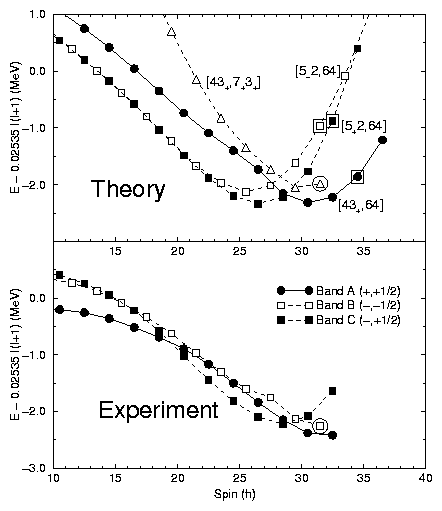| Band Termination in the 73Br Nucleus B, E | |||
|---|---|---|---|
| C. Plettner1, H. Schnare, R. Schwengner, L. Käubler, F. Dönau, I. Ragnarsson2, A.V. Afanasjev3,4, A. Algora5, G. de Angelis5, A. Gadea5, D.R. Napoli5, J. Eberth6, T. Steinhardt6, O. Thelen6, M. Hausmann7, A. Müller7, A. Jungclaus7, K. P. Lieb7, D.G. Jenkins8, R. Wadsworth8, A.N. Wilson8 | |||
|
The structure of the 73Br isotope was investigated by using the EUROBALL
spectrometer and the level scheme was published in [1].

In addition, the sign of the signature of the last occupied orbital is given as a subscript, if the number of occupied orbitals in the specific group is odd. The calculated energies of the energetically lowest configurations are compared with experimental energies in Fig. 1, where a rigid rotor reference was subtracted. Based on this comparison the configurations [43+,64] and [5+2,64] were assigned to bands A and C, respectively. Band B is observed up to I = (63/2). The calculations suggest that the [5-2,64] configuration can be assigned to this band at low and medium spin. It is the signature partner of the [5+2,64] configuration assigned to band C. The [5-2,64] configuration is crossed at spin 57/2 by the [43+,7+3+] configuration. The predicted crossing is indeed observed in band B at spin (55/2-). The latter configuration can be related to band B above the band crossing. In the calculations, the [43+,7+3+] configuration (empty triangles in Fig. 1) undergoes a shape change from a collective shape (triaxiality parameter g » +30°) to a non-collective oblate shape (g = +60°) between spins 55/2 and 63/2. This means that collective rotation is no longer possible and the corresponding band terminates at spin 63/2. Since this is the highest spin observed for band B, we conclude that we observed band B up to its termination.
1 FZR and Horia Hulubei NIPNE, Bucharest, P.O. Box MG-6, Romania
References
[1]C. Plettner et al., Phys. Rev. C 62, 014313 (2000)
[2]I. Ragnarsson et al., Phys. Rev. Lett. 74, 3935 (1995)
|